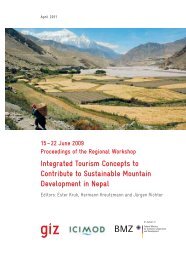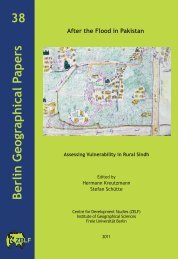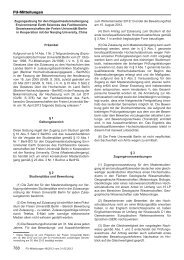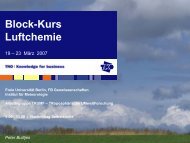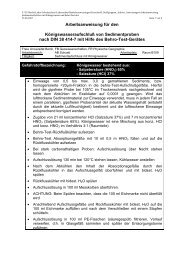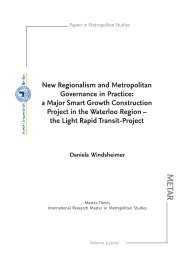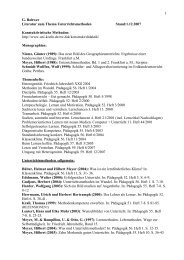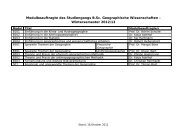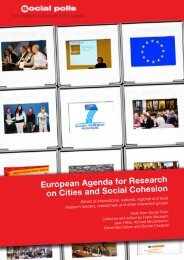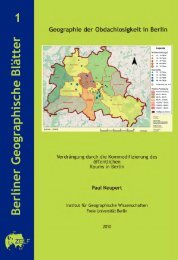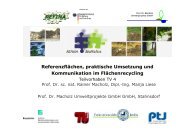Download pdf - Freie Universität Berlin
Download pdf - Freie Universität Berlin
Download pdf - Freie Universität Berlin
You also want an ePaper? Increase the reach of your titles
YUMPU automatically turns print PDFs into web optimized ePapers that Google loves.
Block-Kurs<br />
Luftchemie<br />
<strong>Freie</strong> <strong>Universität</strong> <strong>Berlin</strong>, FB Geowissenschaften<br />
Institut für Meteorologie<br />
Arbeitsgruppe TRUMF – TRoposphärische UMweltForschung<br />
13-17 März 2006<br />
9.00 - 11.00 / 12.00 - 14.00<br />
Peter Builtjes
2<br />
Fokus des Kurses<br />
• Atmosphärische chemische Zusammensetzung der<br />
Troposphäre und der Stratosphäre<br />
• Welche Phenomäne bestimmen die chemische<br />
Zusammensetzung<br />
• Geowissenschaften – Meteorologie – Atmosphärische Chemie<br />
• Atmosphärische Chemie ist wichtig für:<br />
− Strahlungsbilanz und Klimaänderung<br />
− Luftqualität<br />
Block-Kurs Luftchemie<br />
<strong>Berlin</strong>, 13-17 März 2006
3<br />
Struktur des Kurses<br />
Montag : Einführung / Basisprinzipen / Stratosphäre I<br />
Dienstag : Stratosphäre II / Troposphäre I<br />
Mittwoch : Troposphäre II und III<br />
Donnerstagmorgen : Zusammenfassung / Einführung in die Artikeln<br />
Donnerstagmittag : Studieren Artikeln<br />
Freitag : Presentationen<br />
Block-Kurs Luftchemie<br />
<strong>Berlin</strong>, 13-17 März 2006
4<br />
• Teilnahme Schein : 80 % Teilnahme<br />
• Seminar Schein : 80 % Teilnahme + Präsentation<br />
Block-Kurs Luftchemie<br />
<strong>Berlin</strong>, 13-17 März 2006
5<br />
I) Einführung und einige Basisprinzipen<br />
Block-Kurs Luftchemie<br />
<strong>Berlin</strong>, 13-17 März 2006
6<br />
Block-Kurs Luftchemie<br />
<strong>Berlin</strong>, 13-17 März 2006
7<br />
Block-Kurs Luftchemie<br />
<strong>Berlin</strong>, 13-17 März 2006
8<br />
Literatur<br />
Peter Warneck, Chemistry of the Natural Atmosphere, Acadamic Press,<br />
Inc., 1988<br />
E. Meszaros, Atmospheric Chemistry, Elsevier, 1981<br />
John Seinfeld and Spyros Pandis, Atmospheric Chemistry and Physics,<br />
John Wileyd Sons, 1998<br />
Detlev Möller, Luft, Chemie Physik Biologie Reinhaltung Recht,<br />
Walter de Gruyter, 2003<br />
Richard Wayne, Chemistry of Atmospheres, Clarendon Press, 1993<br />
Peter Hobbs, Basic physical Chemistry for the Atmospheric Sciences,<br />
Cambridge Univ. Press, 1995<br />
Junge, Air Chemistry and Radioactivity, Academic Press, 1963<br />
Block-Kurs Luftchemie<br />
<strong>Berlin</strong>, 13-17 März 2006
9<br />
Formation and evolution of the atmosphere<br />
Block-Kurs Luftchemie<br />
<strong>Berlin</strong>, 13-17 März 2006
10<br />
Block-Kurs Luftchemie<br />
Richard Wayne<br />
<strong>Berlin</strong>, 13-17 März 2006
11<br />
Block-Kurs Luftchemie<br />
<strong>Berlin</strong>, 13-17 März 2006
12<br />
Development of the earth atmosphere<br />
1) Proto-planet, gasphase H 2 , He (little CH 4 , H 2 O, NH 3 , H 2 S)<br />
Block-Kurs Luftchemie<br />
followed by dissipation of the leighter atoms<br />
Development of gravitation field and of temperature<br />
(by radioactive heating + solar radiation)<br />
followed by condensation of H 2 O, binding of H<br />
<strong>Berlin</strong>, 13-17 März 2006
13<br />
2) Solid surface, secondairy elements: gases from the solid<br />
earth, outgassing + volcano’s<br />
CH4 , NH3 , H2O, a reducing atmosphere with H<br />
Block-Kurs Luftchemie<br />
proof: Old (3.000 - 1000 million years) Fe-layers are<br />
reduced, not oxidised<br />
vulcano’s lead to CO2 , H2O, N2 , a reducing atmosphere<br />
with O<br />
<strong>Berlin</strong>, 13-17 März 2006
14<br />
Averaged composition of volcanic gas<br />
H 2 O 20 - 97 %<br />
CO 2<br />
N 2<br />
SO 2<br />
Block-Kurs Luftchemie<br />
1-48 %<br />
1-38 %<br />
1-30 %<br />
SO 3 0- 8 %<br />
H 2 0- 4 %<br />
Cl 2 0- 4 %<br />
<strong>Berlin</strong>, 13-17 März 2006
15<br />
3) Surface temperature at the edge between reducing and<br />
oxidysing atmosphere: T ~ -10 / -15 °C<br />
Block-Kurs Luftchemie<br />
With increasing amount of CO2 and H2O (greenhouse effect) T increases to above 0 °C,<br />
liquid water<br />
<strong>Berlin</strong>, 13-17 März 2006
16<br />
Formation of O 2 in the atmosphere<br />
H 2 O + hν →H + OH λ < 195 nm<br />
H 2 O + hν →H 2 + O<br />
O + O + M → O 2 + M<br />
But, O 2 absorbs at λ < 195 nm, blocking<br />
Estimated equilibrium at O2 ~ 0.02 %, 10-3 PAL<br />
(present atmospheric level)<br />
Block-Kurs Luftchemie<br />
<strong>Berlin</strong>, 13-17 März 2006
17<br />
Block-Kurs Luftchemie<br />
<strong>Berlin</strong>, 13-17 März 2006
18<br />
Block-Kurs Luftchemie<br />
<strong>Berlin</strong>, 13-17 März 2006
19<br />
O 2 + hv → O + O<br />
O+ O 2 → O 3<br />
Mehr in Detail später<br />
Block-Kurs Luftchemie<br />
<strong>Berlin</strong>, 13-17 März 2006
20<br />
Live on earth started in a reduced atmosphere<br />
Photosynthesis:<br />
2H 2 O + CO 2 + hν→CH 2 O + H 2 O + O 2 + energy<br />
live in the sea, or in mudded areas because of lack of O 3 -layer<br />
gradual increase of O 2 level to 0.01 - 0.1 PAL<br />
formation of O 3 -layer makes live on the surface possible<br />
Block-Kurs Luftchemie<br />
<strong>Berlin</strong>, 13-17 März 2006
21<br />
Block-Kurs Luftchemie<br />
<strong>Berlin</strong>, 13-17 März 2006
22<br />
Respiration:<br />
C n H m O p + O 2 → H 2 O + CO 2 + energy<br />
(more energy than by photosynthesis)<br />
Fermentation:<br />
C n H m O p → C 2 H 5 OH + CO 2 + energy<br />
Block-Kurs Luftchemie<br />
<strong>Berlin</strong>, 13-17 März 2006
23<br />
Possible fluctuations in concentration levels<br />
1) Higher O 2 levels in the past, upto 25 %<br />
Proof. Current insects about 10 cm<br />
In the past about 50 cm<br />
Probability of forest-fires increases by 70 % with every percent<br />
increase in O2-concentration, leading to decrease in O2-levels Block-Kurs Luftchemie<br />
<strong>Berlin</strong>, 13-17 März 2006
24<br />
Block-Kurs Luftchemie<br />
<strong>Berlin</strong>, 13-17 März 2006
25<br />
Io : a satellite of Jupiter. Active volcano’s, atmosphere<br />
with SO2 and O-atoms<br />
Titan : a satellite of Saturn. Possibly pools of liquid CH4 ,<br />
< 91 K<br />
Block-Kurs Luftchemie<br />
<strong>Berlin</strong>, 13-17 März 2006
26<br />
Block-Kurs Luftchemie<br />
<strong>Berlin</strong>, 13-17 März 2006
27<br />
Block-Kurs Luftchemie<br />
The chemical composition of the<br />
atmosphere is far from equilibrium<br />
Present world Equilibrium world<br />
Air CO 2 0.03 99<br />
N 2 78 0<br />
O 2 21 ~ 0<br />
Ar 1 1<br />
Ocean H 2O 96 63<br />
NaCl 3.5 35<br />
NaNO 3 ~ O 1.7<br />
<strong>Berlin</strong>, 13-17 März 2006
28<br />
Live is the deviation from equilibrium,<br />
the living planet<br />
Gaia hypothesis : James Lovelock<br />
Homeostasis : The eco-system creates the atmosphere,<br />
the environment, in which it feels well<br />
Capacity of control<br />
Block-Kurs Luftchemie<br />
The system contains numerous (delicate)<br />
feed-back mechanisms to keep the balance<br />
<strong>Berlin</strong>, 13-17 März 2006
29<br />
Doom-scenario I<br />
New micro-organisms appear:<br />
They kill the plants/forests<br />
CO 2 rises<br />
T > 100 °C<br />
H 2O-vapour to stratosphere<br />
H 2O + hν →H 2 + O<br />
H 2 escapes to space<br />
3O + N 2 → 2NO 3<br />
NO 3 desolves in the sea, before evaporation<br />
Results in CO 2-atmosphere at high temperatures: Venus<br />
Block-Kurs Luftchemie<br />
<strong>Berlin</strong>, 13-17 März 2006
30<br />
Doom-scenario II<br />
New micro-organisms appear:<br />
They consume nearly all CO 2<br />
CO 2 decreases<br />
T decreases to ~ -10 / -15 °C<br />
Atmosphere with some CO 2 , some H 2 O: Mars<br />
Block-Kurs Luftchemie<br />
<strong>Berlin</strong>, 13-17 März 2006
31<br />
Current composition of the earth atmosphere<br />
N 2<br />
O 2<br />
Block-Kurs Luftchemie<br />
78.09 %<br />
Ar 0.93 %<br />
CO 2<br />
Ne 18.2 ppm<br />
He 5.24 ppm<br />
CH 4<br />
Kr 1140 ppb<br />
20.95 %, very minor decrease by increase of CO 2<br />
0.0036 %, equals 360 ppm, pre-industrial 270 ppm<br />
1.8 ppm = 1800 ppb, pre-industrial 600 ppb<br />
Composition of the dry atmosphere, H 2O-vapour between 0.02-4 %<br />
in the troposphere<br />
<strong>Berlin</strong>, 13-17 März 2006
32<br />
Units<br />
ppm : parts per million : 10 -6<br />
ppb : parts per billion : 10 -9<br />
ppt : parts per trillion : 10 -12<br />
Nearly always : volume ratio: ppm (ν)<br />
Sometimes : mass ratio<br />
Example : O 2: 20.95 % is volume ratio (ν)<br />
Moleculair weight O2 :32<br />
Averaged moleculair weight air : 29<br />
O2 mass-ratio : 20.95 x 32/29 = 23.1 % (m)<br />
Block-Kurs Luftchemie<br />
<strong>Berlin</strong>, 13-17 März 2006
33<br />
Also used, especially in air quality: mass/volume:<br />
gr/m3 , or μgr/m3 (10-6 gr)<br />
ppm (ν) = RT/pMi x conc. in μgr/m 3<br />
Mi is moleculair weight<br />
So, μgr/m3 is function from T and p<br />
Often μgr/m3 STP = standard temperature and pressure:<br />
1013 hPa and 20 °C (293 K)<br />
Block-Kurs Luftchemie<br />
<strong>Berlin</strong>, 13-17 März 2006
34<br />
Atmospheric residence time<br />
The earth + atmosphere is a (nearly) closed system<br />
(only not for H2 , but the sun-wind contains protons~<br />
no effective loss of H2 )<br />
Definition: The mean residence time of a gasmolecule:<br />
t = mass of gas in the atmosphere / emission per time-unit<br />
= mass ... / sink per time unit<br />
In case of equilibrium<br />
Block-Kurs Luftchemie<br />
<strong>Berlin</strong>, 13-17 März 2006
35<br />
Emission : Anthropogenic and/or biogenic and/or natural<br />
(geogenic)<br />
Sink : dry deposition and/or wet deposition and/or<br />
chemical conversion<br />
Block-Kurs Luftchemie<br />
<strong>Berlin</strong>, 13-17 März 2006
36<br />
Example<br />
Total mass of the atmosphere : 5.15 10 18 kg<br />
(total mass of the oceans:<br />
1.4 1021 kg, mass of the earth : 6.0 1024 kg)<br />
N2 . 78 % 3.9 1018 kg<br />
N2-emission . biogenic : 1012 kg/year<br />
anthropogenic : 0.06 1012 kg/year<br />
t = 3.9 10 6 year<br />
Block-Kurs Luftchemie<br />
<strong>Berlin</strong>, 13-17 März 2006
37<br />
Block-Kurs Luftchemie<br />
<strong>Berlin</strong>, 13-17 März 2006
38<br />
Junge’s law<br />
C = C + C* (fluctuation)<br />
C1 = √ C *2<br />
⎯ C 1<br />
⎯ = a.T -b<br />
C<br />
T in years; a = 2.16.10 -2 ; b = 0.95<br />
Block-Kurs Luftchemie<br />
<strong>Berlin</strong>, 13-17 März 2006
39<br />
Ρελατιϖε Στανδαρδ Δεϖιατιον<br />
10 2<br />
10 0<br />
10 −2<br />
10 −4<br />
10 −6<br />
Ρν<br />
10−3 100 103 106 Τροποσπηεριχ Ρεσιδενχε Τιμε/ψρ<br />
Regel van Junge: Empirisch<br />
C1 / C = a T –b a: 2.16.10-2 Block-Kurs Luftchemie<br />
Ο 3<br />
Η 2 Ο<br />
ΧΗ 4<br />
b: 0.95<br />
T in jaren<br />
ΧΟ<br />
ΧΟ 2<br />
Η 2<br />
Ν 2 Ο<br />
getrokken lijn<br />
gestippelde lijn: C1 / C . T = 0.14<br />
Dus: grote spreiding<br />
Ο 2<br />
Ηε<br />
<strong>Berlin</strong>, 13-17 März 2006
40<br />
Atmospheric mixing time scales<br />
Troposphere, zonal average ≈ 2 weeks<br />
Troposphere, global ≈ 1-2 years<br />
Troposphere + stratosphere, global ≈ 2-5 years<br />
Small τ: large variation in concentration in time and place<br />
Large τ: constant (not at sources/sinks)<br />
Block-Kurs Luftchemie<br />
<strong>Berlin</strong>, 13-17 März 2006
41<br />
Some general concepts concerning global circulation and<br />
transport / turbulent diffusion<br />
Some general concepts concerning chemistry, photo-chemistry,<br />
radiation<br />
Block-Kurs Luftchemie<br />
<strong>Berlin</strong>, 13-17 März 2006
42<br />
Block-Kurs Luftchemie<br />
<strong>Berlin</strong>, 13-17 März 2006
43<br />
Block-Kurs Luftchemie<br />
<strong>Berlin</strong>, 13-17 März 2006
44<br />
Turbulent diffusion / Eddy diffusion is essential to describe the<br />
concentration patterns<br />
Kz ~ 1-10 m 2 /s<br />
Ky ~ 2.10 +6 m 2 /s<br />
Block-Kurs Luftchemie<br />
<strong>Berlin</strong>, 13-17 März 2006
45<br />
Block-Kurs Luftchemie<br />
<strong>Berlin</strong>, 13-17 März 2006
46<br />
Block-Kurs Luftchemie<br />
<strong>Berlin</strong>, 13-17 März 2006
47<br />
Block-Kurs Luftchemie<br />
<strong>Berlin</strong>, 13-17 März 2006
48<br />
Chemical reactions occur by adding energy to the system:<br />
By – elevated – temperature or by radiation.<br />
In the atmosphere the strongest driving force is radiation,<br />
sunlight, so photo-chemistry. Thermal reactions are less<br />
important.<br />
Some aspects: Mass-conservation. Stoichiometry<br />
Example: CH 4 + 2O 2 → CO 2 + 2H 2 O (only at T > 400 °C)<br />
This is the overall reaction<br />
Block-Kurs Luftchemie<br />
<strong>Berlin</strong>, 13-17 März 2006
49<br />
Block-Kurs Luftchemie<br />
<strong>Berlin</strong>, 13-17 März 2006
50<br />
Block-Kurs Luftchemie<br />
<strong>Berlin</strong>, 13-17 März 2006
51<br />
Energy →<br />
AB + C<br />
Depiction of the transition state for a bimolecular reaction<br />
Block-Kurs Luftchemie<br />
E act<br />
ΔH<br />
(ABC) + +<br />
Reaction Path →<br />
E: Activatie Energy<br />
Exotherme reactie<br />
<strong>Berlin</strong>, 13-17 März 2006<br />
A + BC
52<br />
Block-Kurs Luftchemie<br />
<strong>Berlin</strong>, 13-17 März 2006
53<br />
AB + hν →A + B (dissociation)<br />
dn ab<br />
dt<br />
Block-Kurs Luftchemie<br />
= n ab . j i<br />
j i = photo-dissociation constant<br />
ji = ∫ ∅i (λ) σab (λ) I (λ) d λ<br />
Δλ<br />
∅ i (λ) : Quantum yield<br />
= product molecules formed/cm3 s<br />
photons absorbed/cm3 s<br />
<strong>Berlin</strong>, 13-17 März 2006
54<br />
σ ab (λ) : Absorption cross-section<br />
I (λ) : Local photo flux<br />
I total<br />
Block-Kurs Luftchemie<br />
=I direct (taking into account absorption)<br />
+I diffuse<br />
+ I reflected (at earth surface and clouds)<br />
<strong>Berlin</strong>, 13-17 März 2006
55<br />
Attenuation of solar radiation in the<br />
atmosphere<br />
UV-A 100 - 280 nm<br />
UV-B 280 - 315 nm<br />
UV-C 315 - 400 nm<br />
Visible light 400 - 800 nm<br />
Infra-red > 800 nm<br />
Block-Kurs Luftchemie<br />
<strong>Berlin</strong>, 13-17 März 2006
56<br />
Block-Kurs Luftchemie<br />
<strong>Berlin</strong>, 13-17 März 2006
57<br />
Block-Kurs Luftchemie<br />
<strong>Berlin</strong>, 13-17 März 2006
58<br />
Block-Kurs Luftchemie<br />
<strong>Berlin</strong>, 13-17 März 2006
59<br />
Block-Kurs Luftchemie<br />
Stratospheric chemistry<br />
and other trace gases<br />
First, some observations<br />
<strong>Berlin</strong>, 13-17 März 2006
60<br />
Block-Kurs Luftchemie<br />
<strong>Berlin</strong>, 13-17 März 2006
61<br />
Block-Kurs Luftchemie<br />
<strong>Berlin</strong>, 13-17 März 2006
62<br />
At 55 ° N January 360 DU<br />
Block-Kurs Luftchemie<br />
March 400 DU<br />
May 370 DU<br />
July 360 DU<br />
September 310 DU<br />
November 320 DU<br />
DU = Dobson Unit = equivalent column height at standard<br />
pressure and temperature, in units of 10 -2 mm<br />
<strong>Berlin</strong>, 13-17 März 2006
63<br />
Block-Kurs Luftchemie<br />
<strong>Berlin</strong>, 13-17 März 2006
64<br />
Formation of stratosphere O 3<br />
O 2 + hν O + O j a<br />
O + O 2 + M O 3 + M k b<br />
O 3 + hν O 2 + O j c<br />
O + O 3 O 2 + O 2 k d<br />
Role of stratospheric O3 :<br />
• Absorption λ < 300 nm<br />
• Temperature increase in the stratosphere<br />
Block-Kurs Luftchemie<br />
<strong>Berlin</strong>, 13-17 März 2006
65<br />
III. Stratospheric chemistry<br />
Most of atmospheric chemistry is photo-chemistry<br />
Solar spectrum<br />
Photo-dissociation of O2 O2 + hV O + O (‘D) λ 180-240 nm<br />
Block-Kurs Luftchemie<br />
50 km 30 km 15 km<br />
J (O 2) [s -1 ] 10 -9 5.10 -11 10 -14<br />
Photo-dissociation of O 3<br />
O 3 + hV O 2 + O (‘D) 200-300 nm<br />
50 km 30 km 15 km<br />
J (O 3) [s -1 ] 8.10 -3 10 -3 7.10 -4<br />
Remark: O (‘D) + H 2O OH<br />
<strong>Berlin</strong>, 13-17 März 2006
66<br />
n1 n2 n3 nm dn 1<br />
dt<br />
dn 2<br />
dt<br />
dn 3<br />
dt<br />
Block-Kurs Luftchemie<br />
: conc. O<br />
: conc. O2 : conc. O3 : conc. (N2 + O2 )<br />
=2 j a n 2 –k b n 1 n 2 n m<br />
+ j c n 3 –k d n 1 n 3<br />
=–j a n 2 –k b n 1 n 2 n m<br />
+ j c n 3 + 2k d n 1 n 3<br />
=k d n 1 n 2 n m + j c n 3<br />
–k d n 1 n 3<br />
<strong>Berlin</strong>, 13-17 März 2006
67<br />
In addition:<br />
n 2 (O 2) >> n 1 (O) + n 3 (O 3)<br />
dn 2<br />
⇒ = 0<br />
dt<br />
n 1 (O) in equilibrium in 10-20 sec<br />
dn 1<br />
⇒ = 0<br />
dt<br />
As result:<br />
B 1 – exp. [-2 (AB) ½ t]<br />
n3 (O3) = .<br />
A 1 + exp. [-2 (AB) ½ ½<br />
t]<br />
A = 2 k d j c / k b n 2 n m<br />
B = 2 j a n 2<br />
In equilibrium:<br />
Block-Kurs Luftchemie<br />
<strong>Berlin</strong>, 13-17 März 2006
68<br />
Theory of Chapman (1932)<br />
From the 4 reactions follows:<br />
conc. O 3 = conc. O 2<br />
Block-Kurs Luftchemie<br />
( )<br />
K b .j a .conc (N 2 + O 2 ) 0.5<br />
K d .j c<br />
(for equilibrium, long time scales)<br />
Qualitative correct, but factor 2 too high compared<br />
to measurements<br />
<strong>Berlin</strong>, 13-17 März 2006
69<br />
Possible explanation of the overestimation of stratospheric<br />
ozone by Chapman Theory:<br />
• Dynamics, transport. However, this should not influence the<br />
total budget<br />
• Chemistry, missing loss-processes<br />
Remark: This explanation should hold for the natural,<br />
undisturbed stratospheric ozone layer!<br />
Block-Kurs Luftchemie<br />
<strong>Berlin</strong>, 13-17 März 2006
70<br />
O 3 “residence time”<br />
Block-Kurs Luftchemie<br />
50 km 5 - 20 hours<br />
30 km ≈ 1 week<br />
20 km 1 - 3 years<br />
Other stratospheric trace gases<br />
N2O, H2O, CH4 , (CH3Cl etc.)<br />
Origin: the troposphere<br />
<strong>Berlin</strong>, 13-17 März 2006
71<br />
Block-Kurs Luftchemie<br />
<strong>Berlin</strong>, 13-17 März 2006
72<br />
Block-Kurs Luftchemie<br />
N 2 O (ca. 90 % of biogenic origin)<br />
N 2 O + hV N 2 + O ('D) λ ≈ 200 nm<br />
O ('D) + N 2 O N 2 + O 2<br />
2NO<br />
from O 3 -photo-dissociation<br />
<strong>Berlin</strong>, 13-17 März 2006
73<br />
Followed by: NO + O3 NO2 + O<br />
NO2 + hV NO + O<br />
O + O2 + M O3 + M<br />
(NO + NO2 = constant)<br />
O + NO2 NO + O2 (O + O3 2O2) Leading to: O3 + hV O + O2 O + NO2 O2 + NO<br />
NO + O3 NO2 + O2 Netto:<br />
With NOx as catalyst<br />
O3 + O3 2O2 Paul Crutzen: 1970<br />
“The influence of nitrogen oxides on the atmospheric ozone content”<br />
Quart. J.R.Met.Soc. (1970), 320-325<br />
Block-Kurs Luftchemie<br />
<strong>Berlin</strong>, 13-17 März 2006
74<br />
Impact of NO and NO 2 , but also of:<br />
OH<br />
HO 2<br />
No explanation where NO/NO 2 comes from,<br />
mentiones “photodissociation” of N 2 O<br />
But main source is N 2 O + O → 2NO<br />
Block-Kurs Luftchemie<br />
<strong>Berlin</strong>, 13-17 März 2006
75<br />
Block-Kurs Luftchemie<br />
<strong>Berlin</strong>, 13-17 März 2006
76<br />
H2O troposphere: 0.2 - 4%<br />
stratosphere: 2 - 7 ppm<br />
O ('D) + H2O CH4 in the stratosphere<br />
2OH<br />
CH4 + OH H2O + CH3 (lower stratosphere)<br />
CH4 + O ('D) OH + CH3 (higher stratosphere)<br />
CH4 + Cl HCl + CH3 Block-Kurs Luftchemie<br />
<strong>Berlin</strong>, 13-17 März 2006
77<br />
Block-Kurs Luftchemie<br />
<strong>Berlin</strong>, 13-17 März 2006
78<br />
Stratospheric chlorine<br />
Methylchloride: CH3Cl (biogenic)<br />
F11 : CFCl3 (antropogenic)<br />
F12 : CF2Cl2 (antropogenic)<br />
Carbontetrachloride: CCl4 (antropogenic)<br />
Methylchloroform: CH3CCl3 (antropogenic)<br />
Example: CFCl 3 + hV Cl + CFCl 2 λ 170-190 nm<br />
Block-Kurs Luftchemie<br />
CFCl 2 + O 2<br />
COFCl + ClO<br />
<strong>Berlin</strong>, 13-17 März 2006
79<br />
Followed by: Cl + O 3 ClO + O 2<br />
O + ClO Cl + O 2<br />
O 3 + hV O + O 2<br />
Netto: O 3 + O 3 2O 2<br />
With Cl as catalyst<br />
Molina and Rowland: 1974<br />
“Stratospheric sink for chlorofluormethanes:<br />
chlorine atom-catalysed destruction of ozone”<br />
Nature, vol.249, June 28, 1974, 810-812<br />
Block-Kurs Luftchemie<br />
<strong>Berlin</strong>, 13-17 März 2006
80<br />
Loss reactions for Cl<br />
Cl + CH4 HCl + CH3 Cl + HO2 HCl + O2 Cl + H2 HCl + H<br />
CH4 most important reaction<br />
OH + HCl H2O + Cl: slow<br />
Block-Kurs Luftchemie<br />
<strong>Berlin</strong>, 13-17 März 2006
81<br />
Important:<br />
Binding Cl in less reactive compounds<br />
Cl + CH 4 → HCl + CH 3<br />
ClO + NO 2 → ClONO 2<br />
Block-Kurs Luftchemie<br />
<strong>Berlin</strong>, 13-17 März 2006
82<br />
Block-Kurs Luftchemie<br />
<strong>Berlin</strong>, 13-17 März 2006
83<br />
Photo-dissociation in the stratosphere<br />
N 2 O, CFCl 3 , CF 2 Cl 2 , CCl 4<br />
Block-Kurs Luftchemie<br />
(all λ > 175 nm)<br />
No photo-dissociation of CH4 , NH3 Components without H-atoms: photo-dissociation<br />
Components with H-atom: reaction with OH and O ('D)<br />
Photo-dissociation in the troposphere<br />
NO 2 λ 175 - 240 nm<br />
240 - 307 nm<br />
CH 2 O λ < 300 nm<br />
<strong>Berlin</strong>, 13-17 März 2006
84<br />
Stratospheric ozone budget<br />
Block-Kurs Luftchemie<br />
X + O 3<br />
XO + O 2n+1<br />
XO + O 2<br />
X + (n+1) O 2<br />
Netto: O 3 + O 2n+1 (n+2) O 2<br />
n: 0 or 1<br />
X: H, OH, NO, Cl, O<br />
Model calculations, Crutzen & Schmailzel, 1983<br />
Stratosphere, 2-D model<br />
O + O3 2O2 20%<br />
NO + O3 NO2 + O2 30%<br />
H + O3 OH + O2 30%<br />
Cl + O3 ClO + O2 20% anthropogenic<br />
Also: ClO + NO2 ClONO2 <strong>Berlin</strong>, 13-17 März 2006
85<br />
Block-Kurs Luftchemie<br />
<strong>Berlin</strong>, 13-17 März 2006
86<br />
CFC-11 : CFCl3 : last number amount of F<br />
fore-last number amount of H+1<br />
first number amount of C-1<br />
CF C-22 : HCF 2 Cl<br />
Block-Kurs Luftchemie<br />
<strong>Berlin</strong>, 13-17 März 2006
87<br />
Block-Kurs Luftchemie<br />
F 11: DuPont, 1932, for cooling<br />
Production F 11 + F 12<br />
1960 150.10 3 ton/year<br />
1974 800<br />
1982 600<br />
1986 750<br />
spray-can war<br />
<strong>Berlin</strong>, 13-17 März 2006
88<br />
Block-Kurs Luftchemie<br />
Concentrations<br />
1975 1986 1991<br />
F 11 0.1 ppb 0.23 0.30<br />
F 12 0.1-0.2 ppb 0.40 0.50<br />
Residence time<br />
Estimates F 11 F 12<br />
Sze & Wu (1974) 10 year 10-20 years<br />
Singh (1979) 40 70<br />
Crutzen (1987) 75-100 75-100<br />
Elkins (1993) 55 140<br />
<strong>Berlin</strong>, 13-17 März 2006
89<br />
• British Antartic Survey; 1982<br />
• TOMS instrument NASA<br />
Ozone hole: fully unexpected<br />
Normal chemistry can not explain this<br />
Block-Kurs Luftchemie<br />
<strong>Berlin</strong>, 13-17 März 2006
90<br />
Block-Kurs Luftchemie<br />
<strong>Berlin</strong>, 13-17 März 2006
91<br />
Block-Kurs Luftchemie<br />
‘Om het behoud van de ozonlaag’<br />
John Gribbin, DuPoc, Wageningen, 1992<br />
<strong>Berlin</strong>, 13-17 März 2006
92<br />
Block-Kurs Luftchemie<br />
<strong>Berlin</strong>, 13-17 März 2006
93<br />
Situation<br />
Polar night: polar vortex ≈ 60 oS temperature: < -83 oC HNO3 + H2O polar stratospheric<br />
clouds, PSC’s<br />
In the polar night, at the surface of PSC’s:<br />
ClONO2 + HCl Cl2 + HNO3 ClONO2 + H2O HOCl + HNO3 Inactive Cl becomes potential active Cl<br />
Block-Kurs Luftchemie<br />
<strong>Berlin</strong>, 13-17 März 2006
94<br />
At sunrise<br />
Cl2 + hV 2Cl<br />
HOCl + hV OH + Cl<br />
O 3 increase after October:<br />
Block-Kurs Luftchemie<br />
breaking of polar vortex mixing<br />
T > - 83 oC, no polar clouds<br />
<strong>Berlin</strong>, 13-17 März 2006
95<br />
Block-Kurs Luftchemie<br />
PSC: Polar Stratospheric Clouds<br />
Key Role<br />
<strong>Berlin</strong>, 13-17 März 2006
96<br />
Block-Kurs Luftchemie<br />
<strong>Berlin</strong>, 13-17 März 2006
97<br />
Stratospheric ozone worldwide<br />
• Seasonal variation ≈ 50 DU<br />
• Solar cycle ≈ 6 DU<br />
• Quasi-biennal oscillations ≈ 8 DU<br />
• Vulcano’s ≈ ...<br />
Block-Kurs Luftchemie<br />
<strong>Berlin</strong>, 13-17 März 2006
98<br />
Block-Kurs Luftchemie<br />
<strong>Berlin</strong>, 13-17 März 2006
99<br />
Increase of UV-B leads to:<br />
• Increase in melonomia, skin cancer<br />
• 1% less O 3 leads to 4 % more skin cancer<br />
• Eye-problems<br />
• Damage to protection-system at the skin-surface<br />
• Damage to plancton<br />
Block-Kurs Luftchemie<br />
<strong>Berlin</strong>, 13-17 März 2006
100<br />
1) Ozone depletion potential-ODP<br />
mean O3-depletion due to kg. of species X, divided by:<br />
mean O3-depletion due to kg. CFC-11<br />
2) Global warming potential-GWP<br />
increase radiative forcing due to kg of species X, divided by:<br />
increase radiative forcing due to kg.CO2 (or CFC-11)<br />
3) Atmospheric residence time<br />
Block-Kurs Luftchemie<br />
<strong>Berlin</strong>, 13-17 März 2006
101<br />
Block-Kurs Luftchemie<br />
<strong>Berlin</strong>, 13-17 März 2006
102<br />
Block-Kurs Luftchemie<br />
<strong>Berlin</strong>, 13-17 März 2006
103<br />
Block-Kurs Luftchemie<br />
<strong>Berlin</strong>, 13-17 März 2006
104<br />
Block-Kurs Luftchemie<br />
<strong>Berlin</strong>, 13-17 März 2006
105<br />
Block-Kurs Luftchemie<br />
<strong>Berlin</strong>, 13-17 März 2006
106<br />
Block-Kurs Luftchemie<br />
<strong>Berlin</strong>, 13-17 März 2006
107<br />
Block-Kurs Luftchemie<br />
<strong>Berlin</strong>, 13-17 März 2006
108<br />
Block-Kurs Luftchemie<br />
<strong>Berlin</strong>, 13-17 März 2006
109<br />
Koplung Klima-änderung und<br />
Stratosphärische O 3-Schicht<br />
Erhöhte CO 2 usw.:<br />
• Erhöhte Temperatur in der Troposphäre<br />
• So, Abkühlung in der Stratosphäre<br />
• Mehr Polar Stratospheric Clouds<br />
J. Austin et al.<br />
“Possibility of an Artic ozone hole in a double-CO 2 climate”,<br />
Nature, vol. 360, Nov. 19, 1992, 221-225<br />
Block-Kurs Luftchemie<br />
<strong>Berlin</strong>, 13-17 März 2006
110<br />
Tropospheric chemistry<br />
• Gasphase chemistry: tropospheric ozone and related<br />
components<br />
• Heterogeneous chemistry: Aerosol physics and chemistry<br />
• Dry and wet deposition<br />
• Chemical Transport Modelling - CTM<br />
• Emissions<br />
Block-Kurs Luftchemie<br />
<strong>Berlin</strong>, 13-17 März 2006
111<br />
Tropospheric ozone<br />
• 90 % of all ozone is in the stratosphere, only about 10 % is in the troposphere<br />
• Ozone concentration in the troposphere increases with height above the surface<br />
• Basic question in 1970: What is the origin of ozone in the troposphere and at groundlevel??<br />
Block-Kurs Luftchemie<br />
Diffusion from the stratosphere (Junge)<br />
Current insight: In the Northern hemisphere:<br />
Produced by anthropogenic emissions (Crutzen)<br />
Total troposphere: 50 % of the ozone from stratosphere<br />
50 % anthropogenic<br />
At ground level : 90-95 % anthropogenic<br />
<strong>Berlin</strong>, 13-17 März 2006
112<br />
Ozone and summersmog<br />
Los Angeles, 1945, Haagen-Smit<br />
Photochemical smog : (smoke + fog = smog) in summer<br />
Wintersmog : London ‘fog’ 1940-1950: SO 2 and Sulfate-aerosols<br />
Summersmog : LA: NOx and Reactive Hydro-carbons<br />
Effects : Eye-irritation, breathing problems (asmatics)<br />
Forest<br />
Plants (tomato’s, tabacco)<br />
Block-Kurs Luftchemie<br />
<strong>Berlin</strong>, 13-17 März 2006
113<br />
Surface-near ozone at Montsouris 1876-1905<br />
(Volz et al., 1986) compared to the Arkona series<br />
Block-Kurs Luftchemie<br />
<strong>Berlin</strong>, 13-17 März 2006
114<br />
Block-Kurs Luftchemie<br />
Observations<br />
<strong>Berlin</strong>, 13-17 März 2006
115<br />
IV. Tropospheric chemistry<br />
Stratospheric chemistry: mostly gasphase<br />
Tropospheric chemistry: gasphase, aquous phase, aerosols<br />
Formation of tropospheric ozone<br />
NO 2 + hV NO + O λ < 410 nm<br />
O + O2 + M O3 + M<br />
O3 + NO NO2 + O2 NO2 + O2 NO + O3 Photo-stationairy state<br />
Block-Kurs Luftchemie<br />
<strong>Berlin</strong>, 13-17 März 2006
116<br />
Increase of tropospheric ozone: shift in<br />
photo-stationairy state:<br />
NO 2 + O 2<br />
Reactive hydrocarbons:<br />
Block-Kurs Luftchemie<br />
NO + O 3<br />
RH + OH + O2 RO2 + H2O RO2 + NO RO + NO2 R: CH 3 , C 2 H 5 etc. etc.<br />
RO + O2 Aldehydes + HO2 H2O + NO NO2 + OH<br />
<strong>Berlin</strong>, 13-17 März 2006
117<br />
Example<br />
CH4 + OH H2O + CH3 CH3 + O2 + M CH3O2 + M<br />
CH3O2 + NO CH3O + NO2 CH3O + O2 HCHO + HO2 CO + OH<br />
stable product<br />
CO2 + H<br />
H + O2 + M HO2 + M<br />
HO2 + NO NO2 + OH<br />
Block-Kurs Luftchemie<br />
<strong>Berlin</strong>, 13-17 März 2006
118<br />
Netto:<br />
CH 4 + 8 O 2 → CO + 4 O 3 + 2 OH + H 2 O<br />
CO + 2 O 2 → CO 2 + O 3<br />
Also:<br />
P (O3 ) = k1 [NO] [RO2 ]<br />
+ k2 [NO] [HO2 ]<br />
Block-Kurs Luftchemie<br />
<strong>Berlin</strong>, 13-17 März 2006
119<br />
Reactive Hydrocarbons: RH's transform NO in NO2 without a<br />
loss of O3 , so leads to increase in O3 concentration<br />
Different RH's have a different Photochemical Ozone Creation<br />
Potential: POCP<br />
Block-Kurs Luftchemie<br />
Initial NO-NO 2<br />
Total, including products<br />
Ethene 2 4<br />
Propene 2 7<br />
1-Butene 2 10<br />
Ethane 2 6<br />
Propane 3 8<br />
<strong>Berlin</strong>, 13-17 März 2006
120<br />
RH : Reactive Hydrocarbons<br />
VOC : Volatile Organic Compounds<br />
NMVOC : Non Methane VOC<br />
Alkanes : Saturated Compounds<br />
Block-Kurs Luftchemie<br />
Examples : Ethane C 2 H 6 atmospheric life-time : 80 days<br />
Propane C 3 H 8<br />
Alkenes : Unsaturated Compounds<br />
Examples : Ethene C 2 H 4 2 days<br />
Propene C 3 H 6 15 hours<br />
Isoprene C 5 H 8 5 hours (biogenic)<br />
15 days<br />
<strong>Berlin</strong>, 13-17 März 2006
121<br />
Alkynes : Example: Acethylene C 2 H 2 30 days<br />
Aromatics : Example: Benzene C 6 H 6 20 days (carciogenic)<br />
Tolueen : C 6 H 5 CH 3 3.6 days<br />
Terpenes : C 10 H 16 2 hours (biogenic)<br />
Aldehydes and ketones : Example: Formaldehyde HCHO 1.6 days<br />
Alcohols : Example: Methanol: CH 3 OH 20 days<br />
Block-Kurs Luftchemie<br />
<strong>Berlin</strong>, 13-17 März 2006
122<br />
Block-Kurs Luftchemie<br />
Ο 2<br />
η<br />
Ο 3<br />
ΝΟ 2<br />
ΝΟ<br />
ΟΗ<br />
ΡΗ<br />
Αλδεηψδεσ<br />
<strong>Berlin</strong>, 13-17 März 2006
123<br />
NO → NO 2 → O 3<br />
RH → Aldehyden<br />
Block-Kurs Luftchemie<br />
Meting in L.A.<br />
<strong>Berlin</strong>, 13-17 März 2006
124<br />
Policy for tropospheric O 3<br />
RH versus NOx abatement,<br />
Non-lineair: NO + O3 NO2 + O2 lowering of NO leads to increase in O3 high RH/NO x -ratio: NO x -strategy<br />
low RH/NO x -ratio: RH-strategy<br />
Biogenic RH-emissions<br />
Block-Kurs Luftchemie<br />
<strong>Berlin</strong>, 13-17 März 2006
125<br />
Block-Kurs Luftchemie<br />
<strong>Berlin</strong>, 13-17 März 2006
126<br />
Normal reactions in Northern Hemisphere,<br />
for NOx < 50 ppt<br />
RH + OH + O 2 → RO 2 + H 2O<br />
RO 2 + NO → RO + NO 2<br />
RO + O 2 → aldehydes<br />
HO 2 + NO → NO 2 + OH<br />
For NOx < 50 ppt<br />
HO 2 + HO 2 → H 2O 2 + O 2<br />
O 3 + HO 2 → 2O 2 + OH<br />
O 3 + OH → O 2 + HO 2<br />
Leads to decrease on O 3-concentration<br />
Block-Kurs Luftchemie<br />
<strong>Berlin</strong>, 13-17 März 2006
127<br />
The formation of the OH-radical, the hydroxyl-radical<br />
O 3 + hν →O 2 + O ('D)<br />
O ('D) + H 2 O → 2 OH<br />
Block-Kurs Luftchemie<br />
<strong>Berlin</strong>, 13-17 März 2006
128<br />
In free troposphere (> 2/3 km)<br />
reaction OH with CH4 , CO most important<br />
In the polluted boundary layers<br />
reaction OH with NO2 and HCHO most important<br />
residence time OH ≈ 0.3 - 25 sec<br />
mean concentration: 5.10 5 molecules/cm 3<br />
Block-Kurs Luftchemie<br />
<strong>Berlin</strong>, 13-17 März 2006
129<br />
OH-radical 'discovered' by Levy, 1971<br />
OH reactes with CH4 , CO, with NO2 , HCHO, H2 , O3 , NH3 ,<br />
SO2 , RH<br />
OH is the cleansing agent of the atmosphere, and determines<br />
the atmospheric life time of species<br />
OH does not react with N 2 , O 2 , H 2 O, CO 2<br />
Block-Kurs Luftchemie<br />
<strong>Berlin</strong>, 13-17 März 2006
130<br />
Block-Kurs Luftchemie<br />
<strong>Berlin</strong>, 13-17 März 2006
131<br />
Trends in the OH-concentration<br />
Increase in O 3<br />
Block-Kurs Luftchemie<br />
Increase in OH<br />
Increase in hv Increase in OH<br />
Increase in H 2 O Increase in OH<br />
Increase in CH 4<br />
Decrease in OH<br />
Increase in CO Decrease in OH<br />
But: increase in CH 4 , CO leads to increase in O 3 also …<br />
Guy Brasseur and Ron Prinn: “Is the ‘cleansing capacity’ of the atmosphere<br />
changing?”<br />
IGBP Newsletter 43, 2002.<br />
Conclusion: Relatively constant since 1850, may be about 20 % less.<br />
<strong>Berlin</strong>, 13-17 März 2006
132<br />
Global CH 4-budget<br />
Emission sources in Tg/ year<br />
Animals 100-220<br />
Rice-paddies 280<br />
Swamp 130-260<br />
Termites 150<br />
Biomass-burning 30-100<br />
Natural gas leakage 20<br />
Coal mines 40<br />
Total ~ 500<br />
Block-Kurs Luftchemie<br />
<strong>Berlin</strong>, 13-17 März 2006
133<br />
Loss term<br />
CH 4 + OH ~ 400 Tg/ year<br />
CH 4 -flux to the stratosphere ~ 60<br />
Total ~ 460<br />
Concentration CH 4<br />
Atmospheric life-time ~ 8 years<br />
Block-Kurs Luftchemie<br />
~ 1800 ppb Northern Hemisphere<br />
~ 1700 ppb Southern Hemisphere<br />
<strong>Berlin</strong>, 13-17 März 2006
134<br />
Biogenic: Anaerob : 2 H 2 + CO 2 → CH 4 + O 2<br />
Block-Kurs Luftchemie<br />
Aerob : CH 4 + 2O 2 → CO 2 + 2H 2 O<br />
Biogenic/Anthropogenic distinction by<br />
14 C production by cosmic radiation t ~ 5700 year<br />
So, 14 C content biogenic emissions = 14 C content trees<br />
14 C content fossil fuel = 0<br />
<strong>Berlin</strong>, 13-17 März 2006
135<br />
Block-Kurs Luftchemie<br />
<strong>Berlin</strong>, 13-17 März 2006
136<br />
Trend increase CH 4-concentration<br />
1970-1985 : 1.5 % / year<br />
1985-1989 : 0.8 % / year<br />
around 1993 : 0 %<br />
1995-2003 : 0.3 % / year<br />
Reason : CH4-emission changes ??<br />
OH increase ??<br />
Block-Kurs Luftchemie<br />
<strong>Berlin</strong>, 13-17 März 2006
137<br />
Block-Kurs Luftchemie<br />
<strong>Berlin</strong>, 13-17 März 2006
138<br />
Han van Dop and Maarten Krol<br />
“Changing trends in tropospheric methane and carbon<br />
monoxide: a sensitivity analysis”. Tellus, 2001<br />
Calculations with a 1-D transport-chemistry model<br />
Ivar Isaksen and Oystein Hov<br />
“Calculation of trends in the tropospheric concentration of O3 ,<br />
OH, CO, CH4 and NOx .Tellus, 39 B, 271-285, 1987<br />
Calculations with a 2-D global transport-chemistry model<br />
Block-Kurs Luftchemie<br />
<strong>Berlin</strong>, 13-17 März 2006
139<br />
I) Eiszeit Methan<br />
Vor 38.000/14.500/11.500 Jahre :<br />
Erwärmung in weniger hundert Jahren<br />
Als reaction steigt auch CH 4 an-verstärkt Temperatur Erhöhung<br />
Quelle unklar:<br />
Im Eiskristalle gelagert CH 4 .H 2 O, vielleicht nicht??<br />
Mehr bei Bacterien?<br />
Block-Kurs Luftchemie<br />
<strong>Berlin</strong>, 13-17 März 2006
140<br />
II) Nature Artikel, Januar 2006<br />
Frank Keppler et al:<br />
Methane emissions from terrestial plants under aerobic<br />
conditions<br />
A lot of discussions!<br />
Block-Kurs Luftchemie<br />
<strong>Berlin</strong>, 13-17 März 2006
141<br />
Tropospheric O 3-budget<br />
A. Inflow from the stratosphere<br />
B. Dry deposition at the surface<br />
C. Chemical production<br />
D. Chemical destruction<br />
No wet deposition, O 3 does not desolves in water<br />
Block-Kurs Luftchemie<br />
<strong>Berlin</strong>, 13-17 März 2006
142<br />
Ad A. Stratosphere-Troposphere exchange<br />
Change in tropopause height<br />
Tropopause folding<br />
Turbulent transport by jet-streams<br />
Small scale turbulence<br />
Estimate: NH 300-500 Tg/ year<br />
Block-Kurs Luftchemie<br />
SH 150-250 Tg/ year<br />
(jet-streams stronger in NH)<br />
<strong>Berlin</strong>, 13-17 März 2006
143<br />
ad B. Deposition flux<br />
V d deposition velocity<br />
Oceans/snow 0.001 m/s<br />
Grassland 0.005 m/s<br />
Forest 0.006 m/s<br />
Result: NH 425 Tg/ year<br />
Block-Kurs Luftchemie<br />
SH 275 Tg/ year<br />
<strong>Berlin</strong>, 13-17 März 2006
144<br />
Ozone Production: NOx and RH<br />
Ozone Destruction: by hν<br />
Somewhat by O 3 + OH → HO 2 +O 2<br />
O 3 + HO 2 → 2O 2 + OH<br />
Conc. O 3 NH tropics 35 ppb<br />
> 30 ° N 45 ppb<br />
Total: NH 140 Tg<br />
SH 120 Tg<br />
Block-Kurs Luftchemie<br />
SH tropics 30 ppb<br />
< 30 ° S 40 ppb<br />
Atmospheric life time NH 100 days<br />
SH 120 days<br />
<strong>Berlin</strong>, 13-17 März 2006
145<br />
Block-Kurs Luftchemie<br />
Calculations with a global chemical<br />
transport model<br />
In Tg/year<br />
Pre-industrial 2000<br />
Chem. Prod. 1384 2212<br />
Chem. Destr. 1327 2020<br />
Netto 12 194<br />
Dep.Flux 400 678<br />
Strat. Flux 388 388<br />
<strong>Berlin</strong>, 13-17 März 2006
146<br />
Block-Kurs Luftchemie<br />
2-D model<br />
<strong>Berlin</strong>, 13-17 März 2006
147<br />
Dry Deposition<br />
Flux = Fs [conc. m/s]<br />
Fs = Kz (z)<br />
- Fs = ( C (z)ref – C (o) ) /<br />
o<br />
Block-Kurs Luftchemie<br />
∂C<br />
∂ z<br />
= ( C (z)ref – C (o) ) / ra (z)<br />
zref : reference hight, within the constant flux-layer<br />
ra (z) : atmospheric resistance<br />
rb : viscous sublayer<br />
rc : surface resistance<br />
∫<br />
z<br />
d z<br />
K z (z)<br />
<strong>Berlin</strong>, 13-17 März 2006
148<br />
-F s = [ C (z ref) – c (o) ] / r a + r b + r c<br />
with C (o) : concentration at z = 0, often zero:<br />
-F s = V d C (z ref)<br />
V d : Deposition velocity<br />
Block-Kurs Luftchemie<br />
<strong>Berlin</strong>, 13-17 März 2006
149<br />
Block-Kurs Luftchemie<br />
Dry deposition velocity V d in cm/ s<br />
Grassland Water<br />
SO 2 0.8 0.4<br />
O 3 0.8 0.04<br />
HNO 3 2.5 0<br />
NO 2 0.5 0<br />
<strong>Berlin</strong>, 13-17 März 2006
150<br />
Dissolve in water<br />
Δz g<br />
Δz l<br />
F s = ( C gi –C g )<br />
Block-Kurs Luftchemie<br />
D g<br />
Δz g<br />
D l<br />
= ( C l –C li )<br />
Δz l<br />
C l<br />
C gi<br />
C g<br />
C li<br />
air<br />
interface<br />
water<br />
<strong>Berlin</strong>, 13-17 März 2006
151<br />
Dg, Dl = Moleculair Diffusion Coefficient in gasphase<br />
and liquid phase<br />
Cgi = H . Cli<br />
H : Henry Constant<br />
Fs = ( Cl – Cgi / H ) / ( 1/kg H + 1/kl )<br />
D g<br />
Δz g<br />
Block-Kurs Luftchemie<br />
D l<br />
= kg = kl<br />
Δz l<br />
kg, kl : fct (windspeed)<br />
l<br />
Fs = r<br />
( Cl – Cgi / H )<br />
<strong>Berlin</strong>, 13-17 März 2006
152<br />
Block-Kurs Luftchemie<br />
Dry deposition to watersurfaces<br />
Kg K l H V d<br />
SO 2 0.44 9.6 0.02 0.4<br />
O 3 0.51 0.049 3 0.05<br />
Kg, K l , V d in cm/s<br />
<strong>Berlin</strong>, 13-17 März 2006
153<br />
Wet Deposition<br />
Two processes:<br />
• In cloud processes: Gases absorped in droplets followed by<br />
deposition when it rains:<br />
Rain Out<br />
• Below cloud processes:<br />
Wash out<br />
Block-Kurs Luftchemie<br />
<strong>Berlin</strong>, 13-17 März 2006
154<br />
Emissions<br />
Anthropogenic<br />
Biogenic (living species) and natural<br />
Block-Kurs Luftchemie<br />
<strong>Berlin</strong>, 13-17 März 2006
155<br />
Anthropogenic<br />
Combustion:<br />
• C + O 2 → CO 2<br />
• C x H y + O 2 → xCO 2 + 0.5y H 2 O<br />
Incomplete Combustion:<br />
• VOC, CO, CH 4 , Dust (BLACK CARBON!!)<br />
Block-Kurs Luftchemie<br />
<strong>Berlin</strong>, 13-17 März 2006
156<br />
Contained in fuels<br />
S → SO 2<br />
Heavy metals<br />
N → NOx in gas N about 0 %<br />
in coal about 0.5- 3 %<br />
Block-Kurs Luftchemie<br />
<strong>Berlin</strong>, 13-17 März 2006
157<br />
Thermic NO x<br />
• N 2 + O 2 → NO x<br />
• High T + high O 2 → NO high<br />
• Low T + low O 2 → NO low<br />
• Industrial processes:<br />
HF, CFC’s, heavy metals, pesticides, particles etc.<br />
Block-Kurs Luftchemie<br />
<strong>Berlin</strong>, 13-17 März 2006
158<br />
Emissie benzine-auto’s<br />
N 2 78 %<br />
CO 2 12 %<br />
H 2 O 5 %<br />
O 2 1 %<br />
CO 2 %<br />
H 2 2 %<br />
NO 0.06 %<br />
RH 0.08 %<br />
Block-Kurs Luftchemie<br />
<strong>Berlin</strong>, 13-17 März 2006
159<br />
Biogenic Emissions<br />
• Animals: CO 2 , CH 4 , NH 3<br />
• Forests: VOC<br />
• Soil/Bacteria: NO, N 2 O<br />
• Wetlands: CH 4<br />
• Plancton: DMS, H 2 S<br />
Block-Kurs Luftchemie<br />
<strong>Berlin</strong>, 13-17 März 2006
160<br />
Natural emissions<br />
• Sea-salt (NaCl)<br />
• Wind-blown dust (sahara-sand)<br />
• Lightning (NO)<br />
• Natural forest fires (CO 2 , CH 4 , CO, VOC, NO, particles)<br />
• Meteorites (particles)<br />
• Vulcano's (CO 2 , SO 2 , H 2 S, HCl, particles)<br />
Block-Kurs Luftchemie<br />
<strong>Berlin</strong>, 13-17 März 2006
161<br />
The basis of atmospheric<br />
transport-chemistry modelling<br />
∂C i<br />
∂t<br />
∂<br />
∂y<br />
Block-Kurs Luftchemie<br />
∂Ci ∂Ci ∂Ci ∂<br />
+ u + v + w =<br />
∂x ∂y ∂z ∂x<br />
(K h<br />
∂C i )<br />
∂y<br />
+<br />
∂<br />
∂z<br />
(K z<br />
∂C i ) +<br />
∂z<br />
(K h<br />
∂C i ) +<br />
chemistry + emissions – dry deposition – wet deposition<br />
∂x<br />
<strong>Berlin</strong>, 13-17 März 2006
162<br />
3-D Eulerian grid modelling<br />
Global scale, continental scale, urban scale.<br />
Model system at TRUMF : REM/CALGRID ( continental)<br />
+ urban version<br />
Model system at TNO : LOTOS ( continental)<br />
and LOTOS –zoom ( urban)<br />
Characteristics of the model –systems:<br />
Horizontal grid resolution 0.25 x 0.5 latlong, with nesting down to<br />
about 4 x 4 km 2<br />
Vertical layers: 5-10 upto about 3-5 km<br />
Gasphase chemistry (O 3) and aerosol physics and chemistry<br />
Block-Kurs Luftchemie<br />
<strong>Berlin</strong>, 13-17 März 2006
163<br />
Required input data<br />
• Boundary conditions from observations, or global modelling<br />
(TM-3)<br />
• Anthropogenic and biogenic and natural emissions<br />
• Land use data base<br />
• Diagnostic meteorological fields (by Eberhard Reimer)<br />
• Prognostic meteorological fields:<br />
− DWD-LM<br />
− NWP<br />
− MM5-reanalysis<br />
− ECMWF-ERA 40<br />
Block-Kurs Luftchemie<br />
<strong>Berlin</strong>, 13-17 März 2006
164<br />
Model calculations hour-by-hour for one<br />
year, or more<br />
Computer demand : several days on a PC<br />
Purpose of modelling : Understanding the phenomena that<br />
control the chemical composition<br />
Policy applications : emission reduction strategies<br />
Block-Kurs Luftchemie<br />
<strong>Berlin</strong>, 13-17 März 2006
165<br />
Block-Kurs Luftchemie<br />
<strong>Berlin</strong>, 13-17 März 2006
166<br />
Block-Kurs Luftchemie<br />
<strong>Berlin</strong>, 13-17 März 2006
167<br />
Block-Kurs Luftchemie<br />
<strong>Berlin</strong>, 13-17 März 2006
168<br />
Block-Kurs Luftchemie<br />
<strong>Berlin</strong>, 13-17 März 2006
169<br />
Model evaluation:<br />
How reliable present the model the ‘reality’<br />
Aspects:<br />
• Model calculates volume averaged concentrations, observations<br />
are at a specific point<br />
• Observations (might) contain errors, and their spatial<br />
representativity is (often) not well known<br />
• Uncertainty and errors in input data: emissions<br />
• Weak parts of the model as description of vertical exchange<br />
processes and the treatment of clouds<br />
• Chemistry is non-linear: Right for the wrong reasons<br />
Block-Kurs Luftchemie<br />
<strong>Berlin</strong>, 13-17 März 2006
170<br />
Block-Kurs Luftchemie<br />
<strong>Berlin</strong>, 13-17 März 2006
171<br />
Block-Kurs Luftchemie<br />
<strong>Berlin</strong>, 13-17 März 2006
172<br />
Block-Kurs Luftchemie<br />
<strong>Berlin</strong>, 13-17 März 2006
173<br />
Block-Kurs Luftchemie<br />
<strong>Berlin</strong>, 13-17 März 2006
174<br />
Acidification / Eutrophication<br />
and Ground level ozone<br />
Protection of the Ecos-systems: Freshwater, Forests, Vegetation<br />
Block-Kurs Luftchemie<br />
<strong>Berlin</strong>, 13-17 März 2006
175<br />
Critical loads of S- and N- deposition,<br />
depending on the character of the soil<br />
S-Deposition: Acidification<br />
N-Deposition: Acidification and Eutrophication<br />
Ground level Ozone, averaged over the growing season<br />
Block-Kurs Luftchemie<br />
<strong>Berlin</strong>, 13-17 März 2006
176<br />
Data assimilation by combining models and observations<br />
(Kalnay, E (2003). Atmospheric modelling, data assimilation<br />
and predictability.<br />
Cambridge Univc. Press, UK)<br />
Concept:<br />
Model calculated and observed concentrations represent<br />
different sources of information about air quality<br />
concentration levels.<br />
Necessary: Estimation of uncertainties in model calculated and<br />
observed concentrations<br />
Necessary: Decision of weighting these uncertainties<br />
Block-Kurs Luftchemie<br />
<strong>Berlin</strong>, 13-17 März 2006
177<br />
Different methods:<br />
• Optimal Interpolation-OI<br />
• 3-D Var and 4-D Var<br />
• Kalman filtering<br />
M.van Loon, P.Builtjes and A.Segers<br />
“Modelling and data assimilation of ozone”<br />
Air Pollution Modelling and its Application XIV<br />
Kluwer/Plenum, 2001<br />
Preliminary results of applying Kalman filtering for combining<br />
observed and modelled ozone concentrations over Europe<br />
Block-Kurs Luftchemie<br />
<strong>Berlin</strong>, 13-17 März 2006
178<br />
Some examples of global ozone modelling<br />
Some recent calculations of the tropospheric ozone budget<br />
Ozone as greenhouse gas<br />
Impact of climate change on air quality<br />
Block-Kurs Luftchemie<br />
<strong>Berlin</strong>, 13-17 März 2006
179<br />
Increase in surface ozone from transatlantic<br />
transport of North American pollution<br />
(July 1997)<br />
Block-Kurs Luftchemie<br />
<strong>Berlin</strong>, 13-17 März 2006
180<br />
Block-Kurs Luftchemie<br />
<strong>Berlin</strong>, 13-17 März 2006
181<br />
Block-Kurs Luftchemie<br />
ECHAM<br />
<strong>Berlin</strong>, 13-17 März 2006
182<br />
G.J.Roelofs, J. Lelieveld and R.van Dorland<br />
“A three-dimensional chemistry/general circulation model<br />
simulation of anthropogenically derived ozone in the<br />
troposphere and its radiative climate forcing”<br />
J. of Geoph. Res. 102, D19, 23389-23401, 1997<br />
Model calculations with the European Center Hamburg<br />
Model-ECHAM, with pre-industrial and contemporary<br />
emissions<br />
Block-Kurs Luftchemie<br />
<strong>Berlin</strong>, 13-17 März 2006
183<br />
Block-Kurs Luftchemie<br />
Radiative forcing sensitivity of global<br />
surface temperature to changes in<br />
vertical ozone distribution. The heavy<br />
solid line is a least squares fit to onedimensional<br />
model radiativeconvective<br />
equilibrium results<br />
computed for 10 Dobson unit ozone<br />
increment added to each atmospheric<br />
layer. Ozone increases in region I<br />
(below ≈ 30 km) warm the surface<br />
temperature. No feedback effects are<br />
included in the radiative forcing.<br />
From: Lacis et al., 1990<br />
<strong>Berlin</strong>, 13-17 März 2006
184<br />
Block-Kurs Luftchemie<br />
<strong>Berlin</strong>, 13-17 März 2006
185<br />
Block-Kurs Luftchemie<br />
MOGUNTIA<br />
<strong>Berlin</strong>, 13-17 März 2006
186<br />
Peter H.Zimmermann<br />
“Moguntia: A handy global tracer model”<br />
Air Pollution Modelling and its Application, Cambridge,<br />
17th ITM, 1988<br />
Global 3-D model using monthly averaged winds and eddy<br />
diffusion<br />
Block-Kurs Luftchemie<br />
<strong>Berlin</strong>, 13-17 März 2006
187<br />
Block-Kurs Luftchemie<br />
<strong>Berlin</strong>, 13-17 März 2006
188<br />
Block-Kurs Luftchemie<br />
DEM with climate change<br />
<strong>Berlin</strong>, 13-17 März 2006
189<br />
Block-Kurs Luftchemie<br />
1990 (globaal/mondiaal)<br />
<strong>Berlin</strong>, 13-17 März 2006
190<br />
Block-Kurs Luftchemie<br />
<strong>Berlin</strong>, 13-17 März 2006
191<br />
Block-Kurs Luftchemie<br />
<strong>Berlin</strong>, 13-17 März 2006
192<br />
Aerosols, fine particles, particle matter<br />
Definition:<br />
Dispersed system containing solid or liquid particles suspended<br />
in air (cloud droplets are not considered to be aerosols)<br />
Aerosols : Size-spectrum<br />
Chemical composition<br />
Aerosols : Radius > radius molecules<br />
Mass > mass molecules<br />
Aerosols : > 10 -3 μm<br />
Block-Kurs Luftchemie<br />
<strong>Berlin</strong>, 13-17 März 2006
193<br />
Aitken particles : r < 0.1 μm<br />
Fine particles : 0.1 < r < 2.5 μm<br />
Coarse particles : 2.5 < r < 10 μm<br />
Fine particles : r ~ wavelenght of light<br />
Block-Kurs Luftchemie<br />
Particle size < wavelenght of light: Rayleigh scattering<br />
~ wavelenght of light: Mie scattering<br />
<strong>Berlin</strong>, 13-17 März 2006
194<br />
Grenzwerte in Europa<br />
PM10 (diameter)<br />
Jahresmittel wert: 40 μgr/m 3<br />
Tagesmittel wert: 50 μgr/m 3 , max 35 Tagen pro Jahr<br />
Diese Grenzwert gillt überall !!!!<br />
Im Gespäch: Zusätzlich:<br />
PM2.5, Jahresmittel wert: 25 μgr/m 3 , Stadthintergrund<br />
Block-Kurs Luftchemie<br />
<strong>Berlin</strong>, 13-17 März 2006
195<br />
Block-Kurs Luftchemie<br />
<strong>Berlin</strong>, 13-17 März 2006
196<br />
Block-Kurs Luftchemie<br />
<strong>Berlin</strong>, 13-17 März 2006
197<br />
Block-Kurs Luftchemie<br />
<strong>Berlin</strong>, 13-17 März 2006
198<br />
Removal of aerosols by:<br />
• Coagulation + Accumulation<br />
• Wet precipitation<br />
• Sedimentation<br />
Block-Kurs Luftchemie<br />
<strong>Berlin</strong>, 13-17 März 2006
199<br />
Block-Kurs Luftchemie<br />
Coalescence by Brownian motion<br />
−<br />
N<br />
k<br />
l<br />
r<br />
μ:<br />
A<br />
:<br />
:<br />
dynamic gas<br />
:<br />
dN<br />
dt<br />
:<br />
:<br />
=<br />
numbers of<br />
Bolzmann−constant<br />
mean free path<br />
radius<br />
Stokes<br />
kT ⎛<br />
+<br />
μ<br />
⎝<br />
4<br />
3 ⎜1<br />
particles<br />
viscosity<br />
Al<br />
⎞<br />
⎟ N<br />
r ⎠<br />
− Cunningham correction<br />
2<br />
<strong>Berlin</strong>, 13-17 März 2006
200<br />
Wet deposition and aqueous phase chemistry<br />
Cloud-formation by Cloud Condensation Nucleii-CCN<br />
CCN’s are aerosol, size ~ 0.05 μm<br />
In-cloud scaveging : Rain out<br />
Below-cloud scaveging : Wash out<br />
Block-Kurs Luftchemie<br />
<strong>Berlin</strong>, 13-17 März 2006
201<br />
Example for in-cloud scaveging:<br />
SO 2 , gas + H 2 O ↔ SO 2 .H 2 O<br />
In droplets:<br />
SO2 .H2O ↔ H + -<br />
+ HSO3 - + 2-<br />
HSO3 ↔ H + SO3<br />
2- 2-<br />
SO3 + ½O2→ SO4 Block-Kurs Luftchemie<br />
<strong>Berlin</strong>, 13-17 März 2006
202<br />
Cloud-drops can evaporate Aerosols ”back”, called: processing<br />
Cloud-drops can grow and precipitate<br />
Wash out by raindrops<br />
Block-Kurs Luftchemie<br />
<strong>Berlin</strong>, 13-17 März 2006
<strong>Berlin</strong>, 13-17 März 2006<br />
Block-Kurs Luftchemie<br />
203<br />
aerosol<br />
of<br />
radius<br />
:<br />
r<br />
ion<br />
concentrat<br />
number<br />
:<br />
(r)<br />
N<br />
)<br />
(<br />
:<br />
mass<br />
Total<br />
)<br />
:<br />
(<br />
:<br />
drop<br />
of<br />
Radius<br />
:<br />
R<br />
:<br />
out<br />
Wash<br />
3<br />
3<br />
4<br />
2<br />
2<br />
∫<br />
=<br />
r<br />
o<br />
dr<br />
r<br />
N<br />
r<br />
h<br />
R<br />
m<br />
surface<br />
the<br />
above<br />
height<br />
h<br />
h<br />
R<br />
π<br />
π<br />
π
204<br />
Block-Kurs Luftchemie<br />
<strong>Berlin</strong>, 13-17 März 2006
205<br />
Block-Kurs Luftchemie<br />
<strong>Berlin</strong>, 13-17 März 2006
<strong>Berlin</strong>, 13-17 März 2006<br />
Block-Kurs Luftchemie<br />
206<br />
s<br />
m<br />
V<br />
m<br />
kg<br />
m<br />
r<br />
for<br />
g<br />
r<br />
V<br />
s<br />
p<br />
s<br />
/<br />
1<br />
.<br />
0<br />
/<br />
10<br />
.<br />
2<br />
30<br />
viscosity<br />
gas<br />
dynamic<br />
:<br />
μ<br />
density<br />
particle<br />
:<br />
ρ<br />
radius<br />
:<br />
r<br />
law<br />
Stokes'<br />
n<br />
Gravitatio<br />
3<br />
3<br />
p<br />
2<br />
9<br />
2<br />
≅<br />
⎭<br />
⎬<br />
⎫<br />
≅<br />
≅<br />
=<br />
ρ<br />
μ<br />
μ<br />
ρ
207<br />
Block-Kurs Luftchemie<br />
<strong>Berlin</strong>, 13-17 März 2006
208<br />
IV) Messungen von Aerosolen<br />
• Zusammensetzung:<br />
– primär, anthropogen und natürlich<br />
– sekundär anorganisch<br />
– sekundär organisch-biogen und anthropogen<br />
PM 10 und PM 2.5<br />
• Chemie sekundärer Aerosole<br />
• Anzahl Messungen + Zusammensetzung sehr gering<br />
– AFO-2000 Projekt FU-<strong>Berlin</strong>-Reimer<br />
– Messungen Stadt <strong>Berlin</strong>-Lutz<br />
Block-Kurs Luftchemie<br />
<strong>Berlin</strong>, 13-17 März 2006
209<br />
Voerde, Germany, PM10<br />
Metals<br />
1%<br />
Na<br />
4%<br />
UD<br />
26%<br />
NH4<br />
9%<br />
Figure 1 Composition of PM10 expressed in relative units at three sites in Europe.<br />
Block-Kurs Luftchemie<br />
NO3<br />
19%<br />
BC<br />
7%<br />
Barcelona, PM10<br />
Ca<br />
7%<br />
Na<br />
3%<br />
Cl<br />
3%<br />
EC<br />
11%<br />
NH4<br />
9%<br />
NO3<br />
19%<br />
SO4<br />
21%<br />
OC<br />
12%<br />
SO4<br />
22%<br />
OC<br />
27%<br />
BC<br />
OC<br />
SO4<br />
NO3<br />
NH4<br />
Na<br />
Metals<br />
UD<br />
EC<br />
OC<br />
SO4<br />
NO3<br />
NH4<br />
Ca<br />
Na<br />
Cl<br />
Po Valley, PM10<br />
Elements<br />
16%<br />
NH4<br />
11%<br />
NO3<br />
18%<br />
UD<br />
7%<br />
EC<br />
3%<br />
OC<br />
24%<br />
SO4<br />
21%<br />
EC<br />
OC<br />
SO4<br />
NO3<br />
NH4<br />
Elements<br />
UD<br />
<strong>Berlin</strong>, 13-17 März 2006
210<br />
Block-Kurs Luftchemie<br />
<strong>Berlin</strong>, 13-17 März 2006
211<br />
Mean Ångström coefficient (a) and its variance (b) for August 1997 computed from the<br />
Ångström law using all possible combination of wavelengths.<br />
Block-Kurs Luftchemie<br />
<strong>Berlin</strong>, 13-17 März 2006
212<br />
Secondary inorganic aerosol<br />
NO 2 + OH → HNO 3<br />
HNO 3 + NH 3 ↔ NH 4 NO 3<br />
SO 2 + 2OH → H 2 SO 4<br />
H 2 SO 4 + 2NH 3 → (NH 4 ) 2 SO 4<br />
secondary organic aerosol<br />
ROG + OH → Σ α i C i<br />
Block-Kurs Luftchemie<br />
+ NO 3<br />
+ O 3<br />
<strong>Berlin</strong>, 13-17 März 2006
213<br />
V) Erste Ergebnisse Modellierung von<br />
Aerosolen<br />
• REM-Calgrid/RCG und LOTOS und erste Validierung<br />
• Additionelle Information AOD mit ATSR<br />
Hauptbeschränkungen Modellierung:<br />
• Zu wenig gute Beobachtungen<br />
• Wolkenbeschreibung / Chemie / CCN<br />
Block-Kurs Luftchemie<br />
<strong>Berlin</strong>, 13-17 März 2006
214<br />
Average PM 2.5 28 July - 13 August 1997<br />
Block-Kurs Luftchemie<br />
<strong>Berlin</strong>, 13-17 März 2006
215<br />
Average BSOA 28 July - 13 August 1997<br />
Block-Kurs Luftchemie<br />
<strong>Berlin</strong>, 13-17 März 2006
216<br />
Block-Kurs Luftchemie<br />
Primary part of the PM 10 concentrations in 1995 (μg/m 3 )<br />
as modeled by the LOTOS model<br />
20<br />
17.5<br />
15<br />
12.5<br />
10<br />
7.5<br />
5<br />
2.5<br />
0<br />
<strong>Berlin</strong>, 13-17 März 2006
217<br />
0<br />
Average computed (LOTOS) wind blown dust concentration (μg/m3 ) in 1995<br />
Block-Kurs Luftchemie<br />
<strong>Berlin</strong>, 13-17 März 2006<br />
7<br />
6<br />
5<br />
4<br />
3<br />
2
218<br />
Soot ( Russ) is the same as Black Carbon – BC- or Elementary<br />
Carbon-EC<br />
It is produced by burning, so is part of the primary emissions<br />
of PM<br />
PM 2.5 exists to a large extent of BC and Organic Carbon-OC<br />
BC might be the health relevant part of PM 2.5<br />
BC is a greenhouse “gas”, it absorbs light<br />
Block-Kurs Luftchemie<br />
<strong>Berlin</strong>, 13-17 März 2006
219<br />
Block-Kurs Luftchemie<br />
<strong>Berlin</strong>, 13-17 März 2006
220<br />
Block-Kurs Luftchemie<br />
Figure 2 European BC emission (tonnes) derived in this study<br />
<strong>Berlin</strong>, 13-17 März 2006
221<br />
Average computed (LOTOS) Black Carbon concentration (μg/m 3 ) in 1995<br />
Block-Kurs Luftchemie<br />
2<br />
1.5<br />
1.25<br />
1<br />
0.75<br />
0.5<br />
0.25<br />
0<br />
<strong>Berlin</strong>, 13-17 März 2006
222<br />
Block-Kurs Luftchemie<br />
Figure 4<br />
Annual average distribution of BC,<br />
APPM, SO4 , NO3 and NH4 over<br />
Europe (µg/m3 ).<br />
<strong>Berlin</strong>, 13-17 März 2006
223<br />
Block-Kurs Luftchemie<br />
Figure 5<br />
Annual average distribution of<br />
PM2.5 (µg/m3 ) over Europe in the<br />
upper left panel and the associated<br />
fractions of BC, APPM, SO4 , NO3 and NH4 in the other panels.<br />
<strong>Berlin</strong>, 13-17 März 2006
224<br />
Block-Kurs Luftchemie<br />
<strong>Berlin</strong>, 13-17 März 2006
225<br />
Block-Kurs Luftchemie<br />
<strong>Berlin</strong>, 13-17 März 2006
226<br />
Block-Kurs Luftchemie<br />
BC to measurements<br />
<strong>Berlin</strong>, 13-17 März 2006
227<br />
Gemodelleerde PM10 concentratie over Europa (2003)<br />
Block-Kurs Luftchemie<br />
Totaal Anthropogeen (excl zeezout)<br />
<strong>Berlin</strong>, 13-17 März 2006
Model<br />
228<br />
60<br />
50<br />
40<br />
30<br />
20<br />
10<br />
0<br />
Verificatie van model resultaten: PM10<br />
0 10 20 30 40 50 60<br />
Block-Kurs Luftchemie<br />
PM10 Model vs Airbase metingen<br />
Meting<br />
45<br />
40<br />
35<br />
30<br />
25<br />
20<br />
15<br />
10<br />
5<br />
0<br />
Nederland:<br />
PM10 wordt 45 %<br />
onderschat<br />
Correlatie: 0.52-0.62<br />
NL0007R<br />
NL0010R<br />
NL0220A<br />
NL0223A<br />
NL0226A<br />
NL0227A<br />
NL0249A<br />
NL0250A<br />
NL0252A<br />
<strong>Berlin</strong>, 13-17 März 2006<br />
Meting<br />
Model
229<br />
Verificatie van model resultaten: Sulfaat<br />
Modelled concentration (mg/m 3 )<br />
Onzekerheid: Non-lineare trend in SO2-SO4 conversie snelheid<br />
(rol wolken/mist, heterogene reacties etc.)<br />
Block-Kurs Luftchemie<br />
6<br />
5<br />
4<br />
3<br />
2<br />
1<br />
0<br />
SO2<br />
SO4<br />
0 1 2 3 4 5 6<br />
Observed concentration (mg/m 3 )<br />
<strong>Berlin</strong>, 13-17 März 2006
230<br />
Verificatie van model resultaten: Nitraat en ammonium<br />
Modelled concentration (μg/m 3 )<br />
6<br />
5<br />
4<br />
3<br />
2<br />
1<br />
0<br />
TNO3<br />
NO3<br />
0 1 2 3 4 5 6<br />
Block-Kurs Luftchemie<br />
Observed concentration (μg/m 3 )<br />
Modelled concentration (μg/m 3 )<br />
Onzekerheid: Representatie ammoniak<br />
(in de zomer wanneer NH3 de formatie limiteert<br />
5<br />
4<br />
3<br />
2<br />
1<br />
0<br />
TNH4<br />
NH4<br />
0 1 2 3 4 5<br />
Observed concentration (μg/m 3 )<br />
<strong>Berlin</strong>, 13-17 März 2006
231<br />
Konklusionen<br />
Modellierung von Secondär Inorganisch Aerosol-SIA- geht gut<br />
Modellierung von PM10 geht “nicht” gut<br />
Noch laufende Studie, Artikel in Vorbereitung:<br />
A model intercomparison study focussing on episodes with<br />
elevated PM10 concentrations<br />
Block-Kurs Luftchemie<br />
FU, TNO, LISA-Paris, Köln<br />
<strong>Berlin</strong>, 13-17 März 2006
232<br />
I) Die EU-Rahmenrichtlinien und andere<br />
Massnahmen<br />
Massnahmen in Brussel : Focus auf Gesundheit – Stadt<br />
Massnahmen in Genf : Focus auf Eco-system – Laendliche<br />
Gebiete<br />
Bruessel : EU-Rahmenrichtlinien, NEC-Directive<br />
(National Emission Ceilings)<br />
Genf : UNECE-Grenzueberschreitende<br />
Luftverschmutzung-Gothenburg Protokoll<br />
Block-Kurs Luftchemie<br />
<strong>Berlin</strong>, 13-17 März 2006
233<br />
EU-Rahmenrichtlinien<br />
Fuer SO 2 , NO 2 , NO x , PM 10 (PM 2.5 ), Pb, O 3<br />
In der Zukunft: PAK und Schwermetalle<br />
Fuer Stadtgebiete sind NO2 und PM10 /PM2.5 die wichtigsten<br />
Stoffen<br />
(Im allgemeinen ist O 3 in der Stadt niedrig)<br />
Block-Kurs Luftchemie<br />
<strong>Berlin</strong>, 13-17 März 2006
234<br />
Grenzwerte<br />
NO 2<br />
Block-Kurs Luftchemie<br />
40 μg/m3 Jahresmittelwert<br />
200 μg/m3 Stundenmittel, max. 18 x pro Jahr<br />
PM 10 40 μg/m3 Jahresmittelwert<br />
50 μg/m3 Tagesmittel, max. 35 x pro Jahr<br />
In Grossstaedten: Ueberschreitungen, auch in <strong>Berlin</strong><br />
<strong>Berlin</strong>, 13-17 März 2006
235<br />
Konzentrationen in der Stadt sind<br />
bestimmt durch<br />
Grossraeumigen Hintergrund<br />
Allgemeinen Stadt-Hintergrund<br />
Lokale Situation: Hot spots<br />
Block-Kurs Luftchemie<br />
<strong>Berlin</strong>, 13-17 März 2006
236<br />
Block-Kurs Luftchemie<br />
<strong>Berlin</strong>, 13-17 März 2006
237<br />
Block-Kurs Luftchemie<br />
<strong>Berlin</strong>, 13-17 März 2006
238<br />
CALCULATED RCG<br />
80<br />
70<br />
60<br />
50<br />
40<br />
30<br />
20<br />
10<br />
0<br />
NOV10_01<br />
NOV10_07<br />
NOV10_13<br />
NOV10_19<br />
Block-Kurs Luftchemie<br />
NOV11_01<br />
NOV11_07<br />
NOV11_13<br />
NO2 <strong>Berlin</strong>-Buch (Hourly in microgr/m3)<br />
NOV11_19<br />
NOV12_01<br />
NOV12_07<br />
NOV12_13<br />
NOV12_19<br />
NOV13_01<br />
NOV13_07<br />
NOV13_13<br />
NOV13_19<br />
NOV14_01<br />
NOV14_07<br />
NOV14_13<br />
NOV14_19<br />
NOV15_01<br />
OBSERVED<br />
OBSERVATIONS REM/CALGRID<br />
NOV15_07<br />
NOV15_13<br />
NOV15_19<br />
NOV16_01<br />
NOV16_07<br />
NOV16_13<br />
NOV16_19<br />
NOV17_01<br />
NOV17_07<br />
NOV17_13<br />
NOV17_19<br />
NOV18_01<br />
NOV18_07<br />
NOV18_13<br />
<strong>Berlin</strong>, 13-17 März 2006<br />
NOV18_19
239<br />
CALCULATED RCG<br />
45<br />
40<br />
35<br />
30<br />
25<br />
20<br />
15<br />
10<br />
5<br />
0<br />
NOV10_01<br />
NOV10_07<br />
NOV10_13<br />
NOV10_19<br />
Block-Kurs Luftchemie<br />
NOV11_01<br />
NOV11_07<br />
NOV11_13<br />
NOV11_19<br />
PM10 ZARTAU (Hourly in microgr/m3)<br />
NOV12_01<br />
NOV12_07<br />
NOV12_13<br />
NOV12_19<br />
NOV13_01<br />
NOV13_07<br />
NOV13_13<br />
NOV13_19<br />
NOV14_01<br />
NOV14_07<br />
NOV14_13<br />
NOV14_19<br />
NOV15_01<br />
OBSERVED<br />
OBSERVATIONS REM/CALGRID<br />
NOV15_07<br />
NOV15_13<br />
NOV15_19<br />
NOV16_01<br />
NOV16_07<br />
NOV16_13<br />
NOV16_19<br />
NOV17_01<br />
NOV17_07<br />
NOV17_13<br />
NOV17_19<br />
NOV18_01<br />
NOV18_07<br />
NOV18_13<br />
<strong>Berlin</strong>, 13-17 März 2006<br />
NOV18_19
240<br />
Block-Kurs Luftchemie<br />
<strong>Berlin</strong>, 13-17 März 2006
241<br />
Block-Kurs Luftchemie<br />
Preliminary estimate of the average PM2.5 (μg/m3 )concentration<br />
for August 1997, based on ATSR-2 data.<br />
0 to 5<br />
5 to 10<br />
10 to 15<br />
15 to 20<br />
20 to 25<br />
25 to 35<br />
35 to 45<br />
<strong>Berlin</strong>, 13-17 März 2006
242<br />
Many problems in understanding /<br />
modelling of PM10 and PM2.5<br />
In observations : PM2.5 1/3 Anorganic<br />
Block-Kurs Luftchemie<br />
1/3 Organic<br />
1/3 Primary<br />
Coarse Particles: PM10- PM2.5<br />
<strong>Berlin</strong>, 13-17 März 2006
243<br />
In general: Modelled concentrations of especially<br />
PM10 are lower than observations<br />
Possible explanations :<br />
Missing emission-sources : Wind-blown dust<br />
Block-Kurs Luftchemie<br />
Road abrasion<br />
Tyres and brakes<br />
<strong>Berlin</strong>, 13-17 März 2006
244<br />
Aerosols are also relevant for Climate Change<br />
Most aerosols are cooling (reflection)<br />
Estimate over Europe ~ -2 W/m 2<br />
Black Carbon is warming (absorption)<br />
Estimate over Europe ~ +1 W/m 2<br />
Block-Kurs Luftchemie<br />
<strong>Berlin</strong>, 13-17 März 2006
245<br />
Block-Kurs Luftchemie<br />
<strong>Berlin</strong>, 13-17 März 2006
246<br />
M.Schaap et al.<br />
“Anthropogenic black carbon and fine aerosol distribution<br />
over Europe.<br />
J. of Geoph. Res. 109, D 18207, 2004<br />
Model calculations over 1995 over Europe using the LOTOSmodel,<br />
overview paper.<br />
Block-Kurs Luftchemie<br />
<strong>Berlin</strong>, 13-17 März 2006
247<br />
IV) Schlussbemerkungen<br />
• Weitere Untersuchung notwending in der Messung von<br />
PM10/2.5 mit chemische Aufsplittung<br />
• Weitere Untersuchung notwending in der Modellierung<br />
von PM10 /PM2.5 , einschliesslich der Emissionen<br />
• Herausforderung: Kombination von Messungen und<br />
Modellierung bei Data-assimilation / Optimale Interpolation<br />
Block-Kurs Luftchemie<br />
<strong>Berlin</strong>, 13-17 März 2006
248<br />
Jahresmittelwert der PM10-Konzentration für <strong>Berlin</strong>\Brandenburg aus der kleinräumigen Modellrechung<br />
(links, oben), der OI-Methode aus Modell und Beobachtung (links unten) und der Beobachtung<br />
(rechts oben) und der OI-Methode ausschließlich aus Messungen für das Jahr 1999.<br />
Block-Kurs Luftchemie<br />
<strong>Berlin</strong>, 13-17 März 2006
249<br />
Data assimilatie AOD en PM in LOTOS-EUROS<br />
23-5-2000<br />
Exp 2.<br />
Retrieved<br />
Model<br />
Block-Kurs Luftchemie<br />
geässimileerd<br />
<strong>Berlin</strong>, 13-17 März 2006
250<br />
Block-Kurs Luftchemie<br />
Validatie AOD → systeem werkt!<br />
<strong>Berlin</strong>, 13-17 März 2006
251<br />
Block-Kurs Luftchemie<br />
Geschatte PM2.5 concentraties<br />
PM2.5 schattingen nog zeer onzeker door laag aantal AOD<br />
observaties en de grote onzekerheden in de AOD-PM2.5 relatie<br />
<strong>Berlin</strong>, 13-17 März 2006
252<br />
Atmospheric Chemistry / Air quality and<br />
Climate Change are coupled phenomena.<br />
• Example: High ozone concentrations in the hot period of<br />
August 2003<br />
• Tropospheric ozone is a greenhouse gas<br />
• Most aerosols are cooling, BC is warming<br />
• Research question:<br />
• Air quality/atmospheric chemistry situation over Europe in<br />
2050/2100, so in a modified climate.<br />
• Detailed question: OH-radical in 2050/2100 ???<br />
Block-Kurs Luftchemie<br />
<strong>Berlin</strong>, 13-17 März 2006
253<br />
Angebot zum EU-Brussel,<br />
eingereicht März 2, 2006<br />
RACER: Role of Aerosols in Climate Forcing and European<br />
Regional Air Quality:<br />
With U.Cubasch, H. Hübener, J.Fischer, and P.Builtjes and<br />
many more!<br />
Block-Kurs Luftchemie<br />
<strong>Berlin</strong>, 13-17 März 2006
254<br />
Block-Kurs Luftchemie<br />
<strong>Berlin</strong>, 13-17 März 2006




